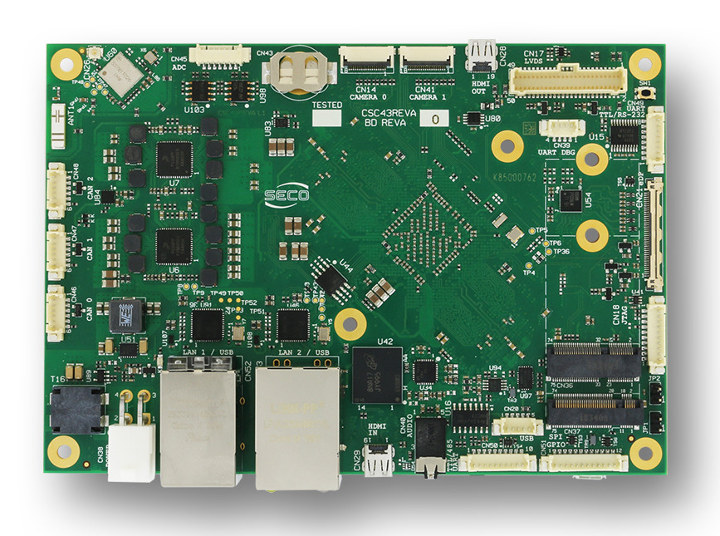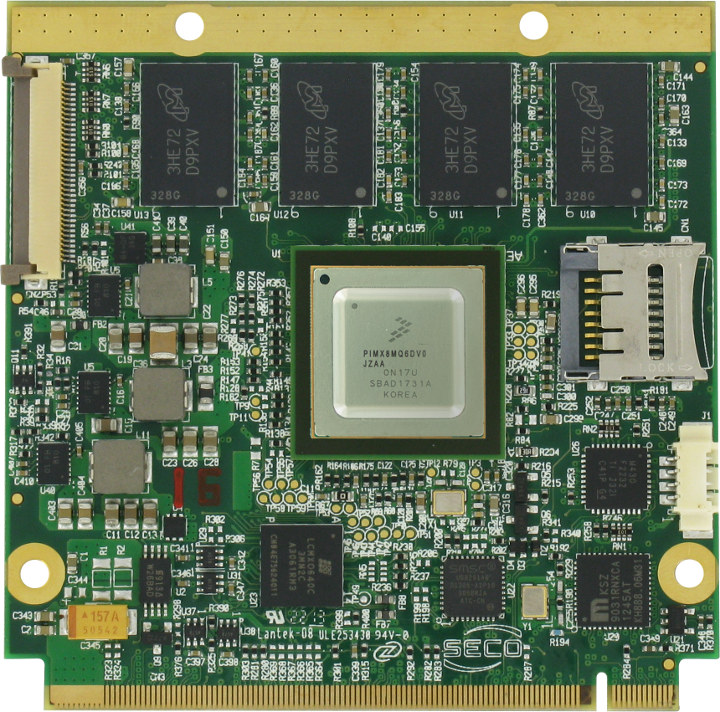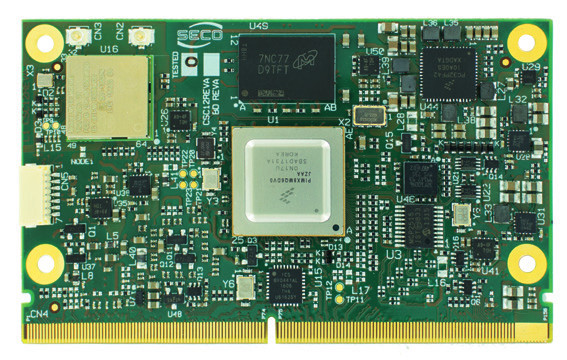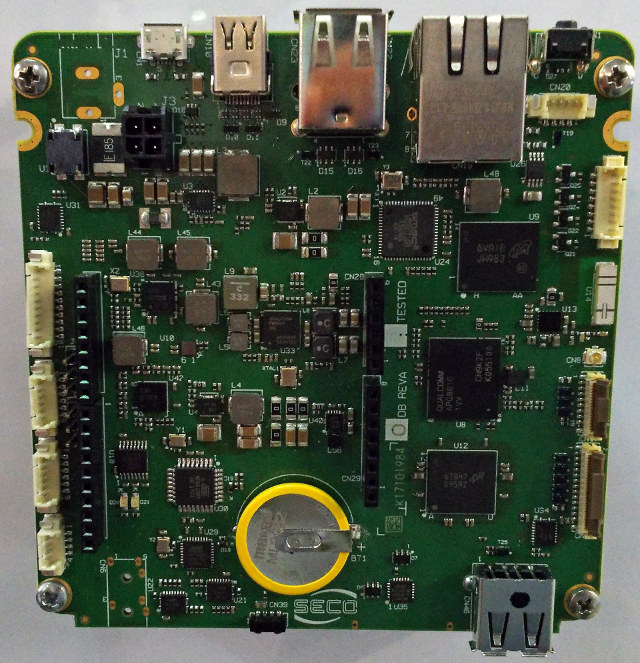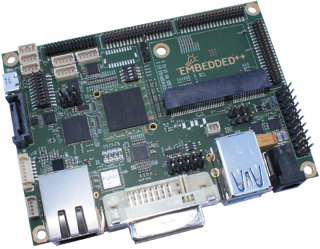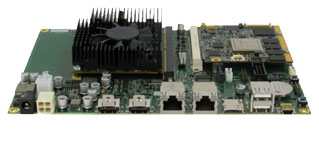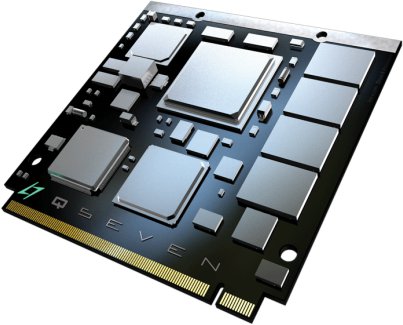When NXP unveiled their first 64-bit i.MX processors in 2016, we had three families: i.MX 8 Cortex-A72/A53 for high performance, i.MX 8M Cortex-A53 for audio/video application, and i.MX 8X Cortex-A53 for low power applications. Most of the designs we’ve seen so far are based on i.MX 8M family, and we’ve seen few hardware platforms based on the top of the line i.MX 8 QuadMax SoC with two Arm Cortex-A72 cores, four Cortex-A53 cores, two Cortex-M4F real-time cores, and two GC7000XS/VX GPUs. We did cover several modules based on i.MX 8 QuadMax processor including Advantech ROM-7720 Qseven 2.1 Computer-on-Module, Toradex Apalis i.MX 8 CoM, and Congatec conga-SMX8 SMARC 2.0 SoM among others, but AFAICR I had yet to see an i.MX 8 QuadMax single board computer. So Seco SBC-C43 appears to be the first SBC powered by NXP’s most powerful i.MX 8 processor, coupled with up to 8GB DDR4, 32GB eMMC […]
SECO Q7-C25 / Q7-C26 QSeven SoMs Feature NXP i.MX 8M / i.MX 8Quad Processor
We’ve previously covered SECO’s SM-C12 SMARC 2.0 i.MX 8M system-on-module, but the company has just unveiled two new module families which are compliant with Qseven – another SoM standard – and powered by NXP i.MX 8M dual/quad core Cortex A53 processor and NXP i.MX 8Quad Cortex A53 or A72/A53 SoC with respectively Q7-C25 and Q7-C26 systems-on-module. SECO Qseven i.MX 8/8M System-on-Module Q7-C25 / Q7-C26 specifications: SoC Q7-C25 (one or the other) NXP i.MX 8M Quad 4x Cortex-A53 cores up to 1.5GHz, 1x Cortex-M4 F real-time core, Vivante GC7000Lite GPU, VPU NXP i.MX 8M Dual 2x Cortex-A53 cores up to 1.5GHz, 1x Cortex-M4 F real-time core, Vivante GC7000Lite GPU, VPU NXP i.MX 8M QuadLite 4x Cortex-A53 cores up to 1.5GHz, , 1x Cortex-M4 F real-time core, Vivante GC7000Lite GPU no VPU Q7-C26 (one or the other) NXP i.MX 8QuadMax 2x Cortex-A72 cores + 4x Cortex-A53 cores + 2x Cortex-M4F cores, 2x Vivante […]
SECO Unveils SM-C12 SMARC 2.0 Compliant i.MX8M Module, CSM-B79 SMARC 2.0 Carrier Board
We’ve already seen several computers-on-module/systems-on-module based on NXP i.MX8/8M processors, most of which use proprietary standards, but so far we’ve covered at least on Qseven 2.1 CoM with Advantech ROM-7720 powered by i.MX 8QuadMax SoC. SECO has now announced their SM-C12 module compliant with another SoM standard: SMARC 2.0. The system-on-module is powered by i.MX 8M dual or quad core processor, supports up to 4GB RAM, offers optional WiFi and Bluetooth connectivity, and plenty of I/Os thanks to the 314-pin MXM3 connector mandated by SMARC 2.0 specification. The module targets home automation, transportation, digital signage and vending machines, multimedia devices, and others applications requiring real-time processing and/or multimedia capabilities. SC-12 module specifications: SoC – NXP i.MX 8M dual or quad Arm Cortex-A53 processor with Cortex-M4 real-time core, Vivante GC7000Lite GPU with support for OpenGL ES 3.1, Open CL 1.2. OpenGL 3.0, Vulkan, DirectX System Memory – LPDDR4-3200 memory, 32-bit interface, […]
Seco brings Snapdragon to the NUC form factor
At Computex last week, Seco was showing off its SBC-B47-eNUC board that’s based on Intel’s NUC (Next Unit of Computing) form factor. NUC type of devices have proven to be fairly popular with companies like Gigabyte, MSI, Asus and ASRock among others having jumped on the trend. However, Seco’s solution is quite different as it’s using a Snapdragon 410E SoC rather than an Intel based processor. Spec wise you’re looking at: SoC – Qualcomm Snapdragon 410E quad core ARM Cortex-A53 @ 1.2GHz with Adreno 306 GPU @ 400MHz System Memory – up to 2GB LP-DDR3 Storage – micro SD slot, Optional eMMC Video Output & Display I/F – mini DP, LVDS Audio – 3.5mm combo mic/speaker jack, internal pin-header for speakers, mic and headphones, I2S pin-header Connectivity – 10/100Mbps Ethernet, Wi-Fi + Bluetooth LE 4.0 USB – 1x micro USB client port port, 2x USB host port (one front, one […]
SECO mITX GPU DevKit Features Nvidia Tegra 3, Supports CUDA 5
SECO mITX GPU DEVKIT is a GPU computing development kit that provides a Mini-ITX Qseven 2.0 carrier board (SECO mITX Carrier Board) with a Nvidia Tegra 3 powered Qseven SoM (QuadMo747-X/T30). The carrier board provides a PCI-e x16 connector (PCI Express x4) intended to allow the connection of CUDA 5 enabled desktop graphics boards. Embedded Control Europe reports that the platform will support Nvidia Kayla platform. The main specifications of the platform are as follows: CPU – Nvidia Tegra 3 Quad-Core ARM Cortex A9 GPU – TBD. But you should be able to insert Nvidia graphics card via the PCI-e x16 connector (PCI Express x4) on the mini-ITX board Memory – 2 GB Storage – 4 GB eMMC + 1x SATA 2.0 Connector Network – 1x Gigabit Ethernet USB – 3x USB 2.0 + 1 OTG port Display – HDMI The platform will support Linux Ubuntu , as well as […]
Texas Instruments OMAP 5 Cortex A15 Systems-on-Module Galore
Today Texas Instruments published a press release to announce partners 6 company had worked to design and manufactures systems-on-module based on the dual core Cortex A15 OMAP 5 SoC and that those would be on display at Electronica Trade Faire this week (13-16 October) in Munich. Embedded++ EPP-Pico-OMAP5430 This solution is actually a Pico-ITX board based on OMAP5430 with 2 GB LP-DDR2, USB 3.0 SuperSpeed connectivity (1x USB 3.0, 3x USB 2.0), up to 16 GB eMMC storage, a SATA port, a 100Mb Ethernet port , UART, RS-323 & SPI ports, GPIOs, DVI and LVDS outputs, a serial camera input port, a micro SD card socket, Murata WiLink 8.0 connectivity solution (Wi-Fi, GNSS, Bluetooth®, Bluetooth v4.0 and FM technologies) and a built-in battery charger (1-cell Li-Ion). The company provides Linux and Android 4.1 BSP. Check the product page for a few more details. GreenBase GK-5432 GK-5432 is a computer on […]
Nvidia Announces CARMA Tegra 3 CUDA Development Kit
Nvidia has just unveiled its Tegra 3 development kit, the Nvidia CARMA. The development kit codename has been crowdsourced as Nvidia asked its followers to propose a name and vote for the best name. This development kit particularly targets CUDA, Nvidia parallel computing platform and programming model that enables dramatic increases in computing performance by harnessing the power of the graphics processing unit (GPU). The CARMA hardware has been designed by Seco and features an NVIDIA Tegra 3 ARM Cortex A9 Quad-Core CPU and NVIDIA CUDA GPU QuatroTM. Here are the technical specs for the development kit: CPU NVIDIA Tegra 3 Quad-Core ARM A9 GPU NVIDIA QuadroTM 1000M with 96 CUDA Cores Memory • CPU Memory: 2 GB • GPU Memory: 2 GB Peak Performance 270 Single Precision GFlops CPU – GPU Interface PCIe x4 Gen1 link Network 1x Gigabit Ethernet Storage 1x SATA Connector USB 3x USB 2.0 Display […]
QSeven Form Factor Embedded Boards by Seco
QSeven is a new standard (QSeven Specifications 1.20) that provides pinout, electromechanical description and implementation guidelines so that the main boards (with the MPU) be easily exchanged. So that you can a larger board with all connectors and a QSeven boards based on Intel icore, Atom or other processors based on ARM that simply fits into that larger board. The QSeven concept is defined as follows: Qseven Concept The Qseven concept is an off-the-shelf, multi vendor, Single-Board-Computer that integrates all the core components of a common PC and is mounted onto an application specific carrier board. Qseven modules have a standardized form factor of 70mm x 70mm and have specified pinouts based on the high speed MXM system connector that has a standardized pinout regardless of the vendor. The Qseven module provides the functional requirements for an embedded application. These functions include, but are not limited to, graphics, sound, mass […]


